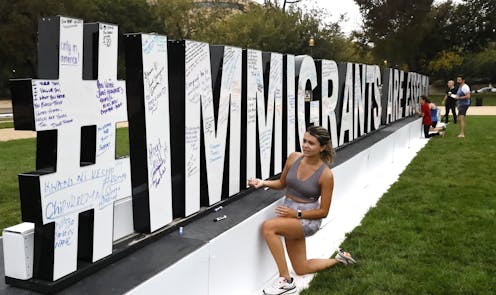Legal work-related immigration has fallen by a third since 2020, contributing to US labor shortages
The immigration decline over the first two years of the coronavirus pandemic led to an annual 1.1% GDP reduction, an economist estimates.

With Americans having fewer children and the nation’s labor force getting older, many employers in manufacturing, aviation and other industries are having trouble finding enough workers.
The gap between the demand for labor and its supply was already forming in 2017. By 2018, the U.S. economy had increasingly more job openings than unemployed workers. That gap has widened during the COVID-19 pandemic as more people have died, retired early or simply dropped out of the job market.
By July 2022, as the pandemic’s effects on the workplace were easing, the U.S. had 11.2 million job openings but only 5.7 million unemployed workers who might fill them.
I’m a scholar of immigration and economics who researches a trend that’s driving labor shortages: declining numbers of immigrants allowed to legally work in the U.S. When I study these numbers, I see an important opportunity to resolve labor shortages that are wreaking economic havoc.
Work visas
An estimated 45 million people living in the United States, roughly 14% of the population, were born elsewhere. About one in six U.S. workers is an immigrant.
Some of these foreign-born workers are legally employed on a temporary basis with an array of visas that make it possible to obtain jobs that run the gamut from software designers to apple pickers.
In some cases, these employees can obtain legal permanent residency – often called “a green card.” Some temporary work visas last longer than 12 months, so the number of workers with authorization is higher than the number of visas issued in that year. H-1B visas, which require a high level of education for fields like computer programming, last three years and can be renewed for another three.
The government issued a record 813,330 temporary employment-based visas in 2019. The total fell by about a third to 566,000 in 2020, as the COVID-19 pandemic got underway, and the numbers were basically flat in 2021 at 566,001 – the first year of Joe Biden’s presidency.
Of course it’s important that the government not issue visas in such a way that foreign workers depress wages or lead to the dismissal of gainfully employed Americans.
These lower wages could occur in the short run, but most empirical studies show there are long-term benefits in terms of what native-born people earn when immigration rises.
Taking a bite out of the economy
The sharp reduction in the number of temporary visas for foreign-born workers in 2020 and 2021 harmed the U.S. economy. Based on my own calculations, the total cost was around 0.4% per year of total gross domestic product – at least $82 billion per year in 2020 and 2021.
Immigration restrictions affected far more people, however, including those who were unable to obtain a green card because of the closure of embassies and consulates. All told, these policies resulted in an estimated 2 million fewer working-age immigrants in the U.S. in 2020 and 2021.
Including those additional losses nearly triples the economic cost of U.S. immigration restrictions to about 1.1% per year of U.S. GDP.
Unless the U.S. reverses course and issues more work-related visas, I estimate that the worker shortage will double to over 4 million by 2030. My calculations also suggest this will shave about 4.3% off of GDP, on average, annually for the next eight years. Adding that all up, that would amount to about $9 trillion in lost economic output.
Labor shortages
Labor shortages are especially severe today in certain industries that rely heavily on immigrants as employees.
For example, in 2020 foreign-born workers accounted for 39% of the farming, fishing and forestry workforce, 30% of all people employed in construction and extraction, 26% of everyone working in computer science and mathematics and 22% in health care support.
As a result, these industries are facing unprecedented challenges in trying to find workers to fill open jobs.
If these labor shortages continue, I’m certain that they will keep hurting job markets, supply chains and productivity as companies have to pay their employees more and then increase prices due in part to those higher labor costs.
The labor force participation rate, which measures the number of people in the job market as a percentage of the total working-age population, has been hovering around the lowest levels seen since the 1970s as more U.S. workers drop out of the job market. After plunging to 60% in 2020, it bounced back partially. The rate stood at 62.2% in July 2022.
Feasible fix
Of course, there are other factors besides a lack of foreign-born visas issued that are responsible for the shortage of workers.
But none are easy to resolve. It’s hard for the government to increase the share of adults who are working, and there’s little that can be done in the short term about the country’s aging workforce – the result of a long-term fertility decline.
Even if the political hurdles can be high, I believe boosting the number of immigrants allowed to legally work in the United States is an important way that the authorities can ease labor shortages.
Jose Ivan Rodriguez-Sanchez receives funding from the Charles Koch Foundation. He is affiliated with Rice University’s Baker Institute for Public Policy.
Read These Next
As DOJ begins to release Epstein files, his many victims deserve more attention than the powerful me
Powerful men connected to Jeffrey Epstein are named, dissected and speculated about. The survivors,…
Medieval peasants probably enjoyed their holiday festivities more than you do
The Middle Ages weren’t as dreary and desperate as you’d think, and peasants often had weeks of…
Why are some Black conservatives drawn to Nick Fuentes?
Black Americans and white nationalists have joined forces in the past. And a number of cultural and…





